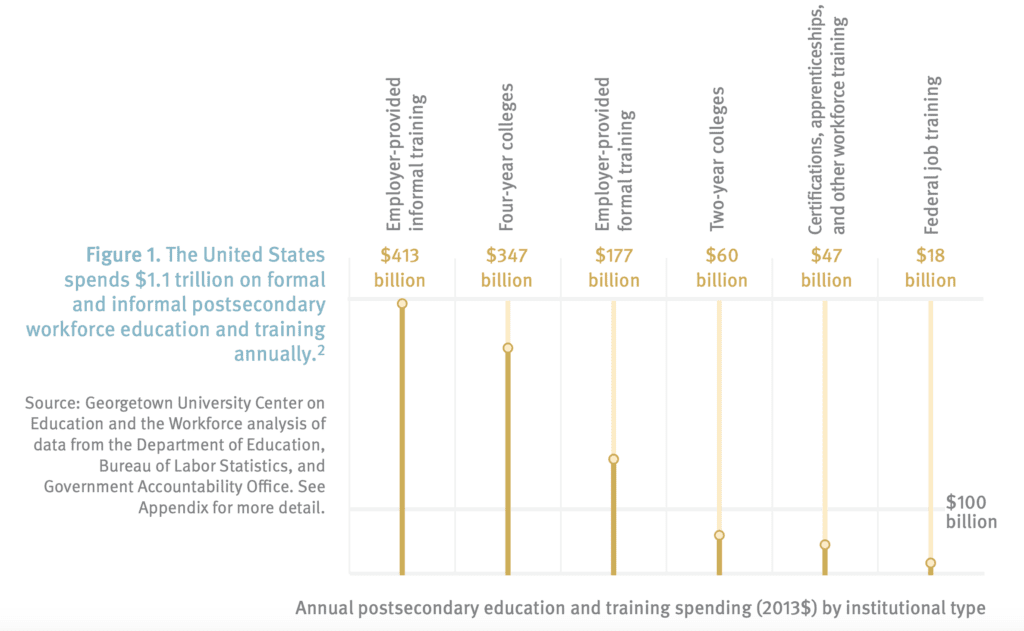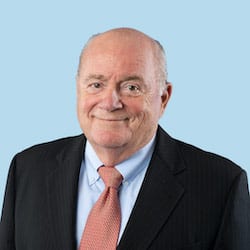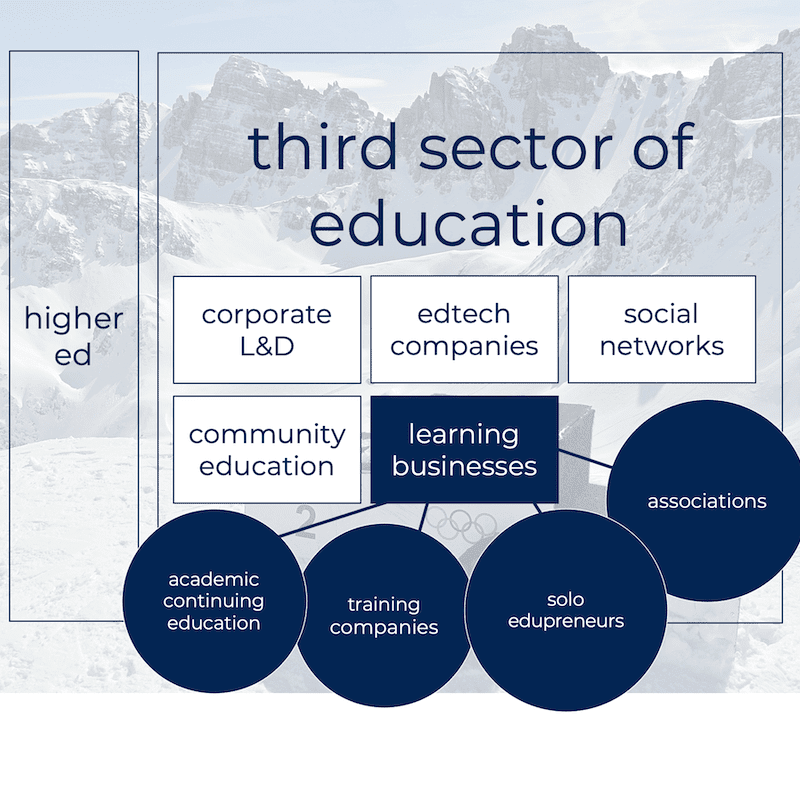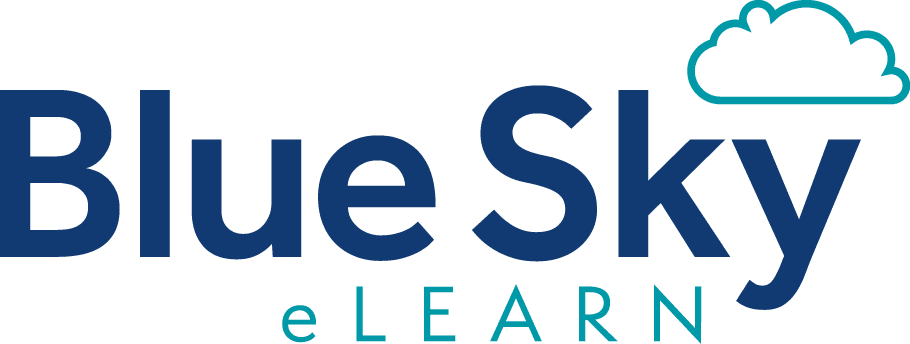This marks the midpoint in our seven-part series on the surge of the third sector of education—the now essential sector serving the continuing education needs of millions of adults in the decades following their secondary and post-secondary education.
In this fourth episode of the series, we reflect on what we’ve learned so far from our conversations with Michelle Weise, author of Long Life Learning: Preparing for Jobs That Don’t Even Exist Yet, and Casandra Blassingame, CEO of the International Accreditors for Continuing Education & Training.
We also pull in some additional perspectives about the growth of the third sector, including that of Dr. Anthony “Tony” Carnevale, research Professor and Director of the Georgetown University Center on Education and the Workforce.
As an internationally recognized economist, Tony explains how economic change has led to the growing demand for providers in the third sector to effectively demonstrate outcomes and results. He also discusses the challenges of a credential-driven society and the related inequalities that exist.
To tune in, just click below. To make sure you catch all of the future episodes, be sure to subscribe by RSS, Apple Podcasts, Spotify, Stitcher Radio, iHeartRadio, PodBean, or any podcatcher service you may use (e.g., Overcast). And, if you like the podcast, be sure to give it a tweet!
Listen to the Show
Access the Transcript
Download a PDF transcript of this episode’s audio.
Read the Show Notes
[00:18] – A recap of what we’ve covered so far in the series.
Note that coming up later in the series are conversations with Nigel Paine, author of Workplace Learning: How to Build a Culture of Continuous Employee Development, and LaTrease Garrison, executive vice president of the Education Division at the American Chemical Society.
Revisiting the Definition of the Third Sector
[01:51] – The “third sector of education” is a term Jeff coined, and we’ve both been using it for several years now.
As a reminder, the first sector is the pre-K through high school system that serves children.
The second sector covers higher education that grants degrees.
Both those sectors are well known.
The third sector of education is less familiar but definitely not new.
That third sector serves the millions of adults who continue to learn and grow in the decades that follow their secondary and post-secondary education.
Many providers make up the third sector: corporate learning and development, learntech companies, even social networking companies like Facebook and LinkedIn, community education, and, of course, learning businesses, which is where we at Leading Learning focus.
And so the third sector is clearly big—serving millions of adults.
But how big?
Well, we got the chance to speak with Dr. Anthony Carnevale, director of the Georgetown University Center on Education and the Workforce (CEW).
They are an independent, nonprofit research and policy institute that studies the link between education, career qualifications, and workforce demands.
Since 2008, the Center has conducted research related to jobs, skills, and equity to better inform students, parents, teachers, and policymakers about the changing relationship between education and careers.
Make sure to check out the many free resources they have available.
Quantifying the Third Sector of Education
[03:49] – An economist’s view is wonderful to have, as it can help with answering that somewhat tricky question of quantifying the size of the third sector of education.
So, what data does the Georgetown University CEW have about the size of the sector?
They published a report called “College Is Just the Beginning” in 2015 that stated that each year the U.S. spends $1.1 trillion on postsecondary education and training. And that $1.1 trillion includes formal and informal education and training.

When we spoke with Tony, we asked him what he knows or can say about what’s happened to spending on post-secondary education and training since 2015, when the “College Is Just the Beginning” report came out.
[05:35] – Tony talks about the increase in spending on post-secondary education and training.
He explains that the most powerful factor of corporate spending is the educational attainment of their workforce.
So to the extent that more and more of the workforce has post-secondary education or training, that actually increases corporate training because you have more trainable people.
Tony further explains that the reason the job requirements now include post-secondary education and training is because technology has automated—and continues to automate—all of the repetitive tasks in any job.
And more and more, especially in a service economy (which is what we are), more of the tasks left to human beings are non-repetitive since it takes more skill to handle non-repetitive tasks.
He also points out there’s been a dramatic shift in the extent to which people work in contact with other people.
This means there’s a whole set of soft skills that are now required in the workforce, which were previously only required of those in leadership positions.
Tony also estimates that formal training in the workplace is about $130 billion.
And then there’s informal training, which is usually roughly three to four times the amount of formal training. So that would make it anywhere from $300 – $400 billion.
He says informal training is really important because it’s what employers prefer. That is, you hire people with skills and more education these days precisely because you think they’re trainable. Meaning you want people who are capable of learning on the job.
The economy is now driven by learning organizations.
Breaking Down Silos
[08:45] – When you’re dealing with something as big as the third sector, it’s inevitable that it’ll be difficult to keep tabs on it all.
And that’s something that came up in our conversation with Michelle Weise.
She called out the duplication of efforts.
Not only is duplication a poor use of limited resources (time, money, mental energy), but Michelle made the point that these siloed approaches also inhibit innovation.
If organizations don’t understand where they dovetail or overlap with others, then they aren’t seeing the issues fully and clearly. And that means they’re hampered in trying to design the most elegant and efficient solutions.
Silos also came up in our conversation with Liam O’Malley, vice president of association solutions at Blue Sky eLearn when asked what he sees as opportunities for those in the third sector.
[09:44] – Liam discusses why it’s important for organizations to work together more and to break down internal silos.
For example, he points out that the people who put on meetings and the people that create courses don’t often talk to each other much. But a lot of the function that they’re providing is very close, or even overlapping.
And when brought together, it can become really powerful in putting together a more holistic strategy.
[10:44] – Note that Liam isn’t just talking about silos between organizations, but within an organization. And those internal silos seem as likely to inhibit innovation as the external silos Michelle mentioned.
We also spoke with Amanda Davis, vice president of continuing education solutions at Blue Sky eLearn, and she predicted more mergers in the learntech space.
We cited some investment and merger activity in the first episode in this series, as we think that’s evidence of the growing importance of the third sector.
Mergers are a potential solution to duplication of efforts.
Another potential way around duplication of effort that Amanda mentioned is avoiding the temptation to be everything to everyone, which can be especially hard for associations who sometimes feel they have to serve the needs of all their members.
[11:44] – But Amanda explains why there’s a need to focus.
That whole idea of being everything to everyone, I believe that will be the sort of the straw that breaks the camel’s back for a lot of these organizations.
She thinks stepping back is part of that strategizing to challenge what you’ve been doing for so long—and doing this by looking at your data.
But Amanda warns not to work towards those small pockets of your membership.
Rather, find those unique value propositions and move towards those to really establish that value in your market.
She believes this isn’t done enough.
So organizations often keep adding things on and then they’re not good at anything. And she thinks that’s going to trouble a lot of organizations in the future—possibly even out of existence.
[13:05] – Amanda mentioned finding those unique value propositions, and that is key.
If your value proposition is in fact unique, then, by definition, you’re not duplicating effort. And it means your learning business has a good awareness of the third sector—you’re aware of the other options and players, and you’re offering something else, something different, something unique.
Sponsor: Blue Sky eLearn
[13:29] – In addition to adding perspectives on the third sector to this series, we’re grateful to Blue Sky eLearn for their financial sponsorship of the podcast.
For nearly 20 years, Blue Sky eLearn has been transforming the way organizations deliver virtual events and educational content. Blue Sky’s customized cutting-edge solutions connect hundreds of organizations to millions of learners worldwide.
These include their award-winning learning management system Path LMS, webinar and live streaming services for short events to multi-day virtual conferences and learning strategy and development solutions. These robust, easy to manage solutions allow organizations to easily organize, track, and monetize educational content.
The Growing Third Sector
[14:27] – In the first episode in this series, we highlight five developments we see contributing to the growth of the third sector of education:
- Shifts in human life and work
- Technology advances
- The surge in content
- Strides in neuroscience
- The pandemic
[15:04] – The growth of the sector came up in our conversation with Tony Carnevale from the Georgetown CEW.
He talks about how in his day, you graduated from high school, you achieved what people called “independent adulthood/economic independence”, and you were ready for family formation.
But nowadays family formation has less and less to do with economic independence.
The age at which most people achieve the economic standard for economic independence is now age 32.
So Tony is adding some nuance to what we put under that heading of shifts in human life and work.
He’s talking about the huge population of people between the ages of 18 and 32, who need education and training.
That’s at the front end of work life and careers.
But there are also older workers, those who have been at a job or in field for some time.
[16:09] – Tony talks about how there’s a whole market for people who need to upgrade their skills who are being left behind by economic change.
We never provided an education or a training solution to keep their jobs or get them new ones. That is now a priority. The issue is going to be who can produce programs that clearly produce results. That’s going to be the change.
What Tony says about producing results is so important—we’ve long talked about the need for learning businesses to show results, to prove that they’re moving the needle, and he’s saying that need is only going to grow as demand for the third sector grows.
See our related episode, One Word: Impact.
So the education and training the third sector provides are now seen as essential.
It used to be that a high school degree could lead to a good job, but that’s rarely the case now.
[17:46] – Tony explains how the economy has evolved to where people are now demanding more outcome standards, particularly in the areas of education and healthcare.
Learning is crucial. Its contribution now to overall GDP and productivity growth is dominant. More than technology. The world has changed, so education and training are cool now, much more so than they used to be—and necessary—and people know that.
He notes that lot of people aren’t happy about that because to some extent it’s led to a tremendous increase in credentialing in America.
Tony adds that only 20 percent of good jobs now go to people with high school degrees, while the rest all come with some sort of credentialed certification, formal/informal training, or non-credit education.
But with greater attention comes greater scrutiny.
With more people recognizing the importance and necessity of the education and training, there’s greater demand for those outcomes, for those results.
[20:29] – Tony emphasizes the need for accountability and transparency, so learners, funders, and society at large can know about the results of any particular education and training offering. He also discusses the big gap the exists by race and class when it comes to access to training/education.
We live in a world now where the race and class inequality has become a real problem. And it’s hard to figure out how we get out of that…So the gap now is huge. Essentially white, upper middle-class and upper middle-class Americans have a 30-year advantage now over blacks, Latinos, and so on. So there is a tough one in the amount of education required to fix. It’s clear that if you’re in this business, it’s a growth business. No doubt about it.
Growing Inequality in Society and the Third Sector
[22:28] – The focus on inequality is a big one for the Georgetown University Center on Education and the Workforce. They focus research and resources on three big areas: jobs, skills, and equity.
And DEI—diversity, equity, and inclusion—is an area of interest and focus for Michelle.
In fact, one of the through lines of Michelle’s work is attention to those left behind and left out of traditional education and training opportunities.
And, if you look at the works cited in her book Long Life Learning: Preparing for Jobs That Don’t Even Exist Yet, you’ll find several items published by the Georgetown University CEW and written by Dr. Carnevale.
They make a lot of great data and research available, so we encourage to check out their site.
Also, for more on the topic of diversity, equity, and inclusion, check out our interview with DEI strategist Shilpa Alimchandani.
So inequality is a huge issue for the third sector.
When we asked Tony about the threats that he sees for the third sector of education and what the Georgetown University CEW is doing to help address those threats, he focused on credentialism—and the inherent inequality of that, at least in this moment.
[23:46] – Tony explains the challenges in having a society driven by credentialing.
He says our solution to that is we’re going to get everybody a credential, whether it be education or training, and we’re going to build what is, effectively, an education and training system.
But there are a lot of issues about who gets the training mission. So far, if you had to look at the big players, it’s education. However he thinks that will expand as we move along.
When it comes to how we will make all this credentialing happen, Tony says that free college is a proposal that’s prominent at the moment.
If you look across institutions, he notes the other piece of this is transparency and accountability—so building a system in which you can measure outcomes.
He says that both of those pieces are pretty well in place but what we don’t know is where all the money’s going to come from.
But that is the way as a society we’re resolving this. That is, nobody can see any other way to do this than to expand this tier of Americans with skill credentials.
Tony stresses that in all parts of our society, we’re going to need to be able to measure the value of this additional education and training.
Another concern that exists is that this is not happening evenly across America.
There’s been a huge increase in inequality in America, economic inequality, since 1983, but 70% of that increase is due to differences in education and training, so it has become a core economic and social problem.
[27:00] The talk of credentialism brings to mind the noise in the marketplace that came up in our conversation with Michelle.
She made that point there are some 730,000 credentials available—that’s a lot.
And we talked with Casandra about it as a potential way to stand out in the crowded marketplace.
That is accreditation of a learning business or a learning business’s program can help separate a credential for the 729,999 others. And that’s, of course, what Casandra’s organization, the International Accreditors for Continuing Education and Training does.
While there can be issues with proxies, in such a crowded marketplace, with so many options for training and education, it seems that accreditation can be a meaningful proxy for results and outcomes.
That is, offerings built to adhere to good standards and independently verified to conform to those standards may rise to the top and be seen as trustworthy and therefore get funding, whether from the public, employers, or from individual lifelong learners spending their hard-earned dollars.
Revisiting the Reflection Questions

[28:20] – Circling back to the inequality point, inequality has bubbled up as an unexpected answer to the “How might a deepened awareness of the third sector help your learning business?” we posed in the first episode of this series.
Or not exactly that inequality might help a learning business but a deepened awareness of the inequality in the third sector now might give a learning business a new mission or focus on their offerings.
So looking at who is being left out and tuning those “non-consumers” into learners (to borrow Michelle’s term “non-consumers,” which she borrowed from Clayton Christiansen).
As a reminder, the other question we posed in the first episode of the series was, “What’s your learning business’s awareness of the third sector of education?”
Our hope is that you’ve been considering that question as well as how a deepened awareness might impact your learning business as you’ve been following this series—and that you’ll continue to consider those questions as you follow what’s still to come in the series.
[29:38] – Wrap-Up
To make sure you don’t miss the remaining episodes in this series, we encourage you to subscribe by RSS, Apple Podcasts, Spotify, Stitcher Radio, iHeartRadio, PodBean, or any podcatcher service you may use (e.g., Overcast). Subscribing also helps us get some data on the impact of the podcast.
Personal recommendations are critical in today’s noisy world, so please take a minute to rate the Leading Learning Podcast on Apple Podcasts. We personally appreciate it, and reviews and ratings help the podcast show up when people search for content on leading a learning business.
And we encourage you to learn more about the sponsor for this series by visiting Blue Sky eLearn.
Finally, consider following us and sharing the good word about Leading Learning. You can find us on Twitter, Facebook, and LinkedIn.
[31:17] – Sign off
Other Episodes in This Series:
- The Third Sector of Education
- Long Life Learning with Michelle Weise
- Accrediting Lifelong Learning with Casandra Blassingame
- Continuous Development with Nigel Paine
- Uncovering Opportunity in Challenges with LaTrease Garrison
- The Third Sector of Education: Sustaining and Shaping Society
Episodes on Related Topics:




 Accrediting Lifelong Learning with Casandra Blassingame
Accrediting Lifelong Learning with Casandra Blassingame
Leave a Reply